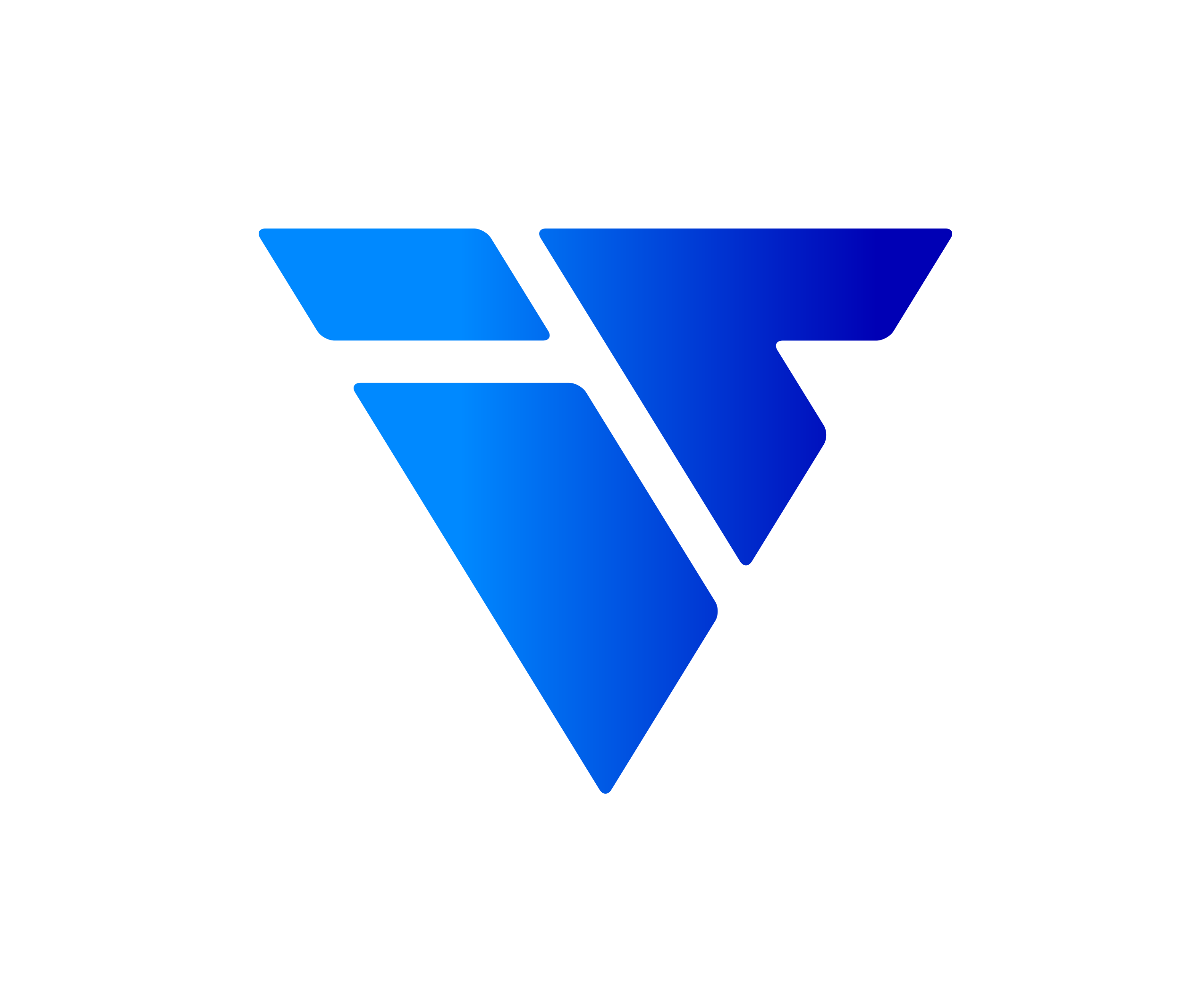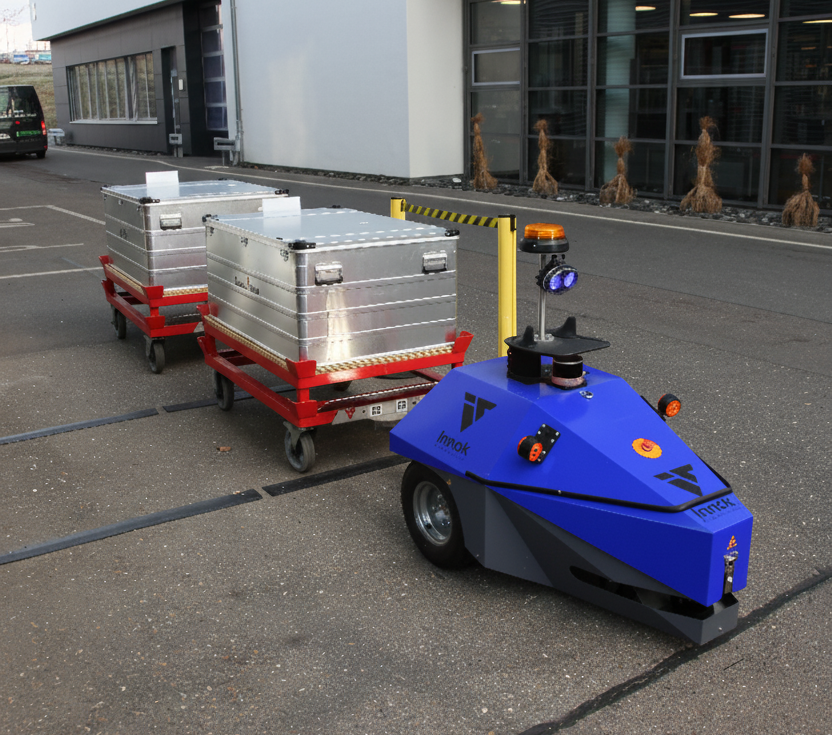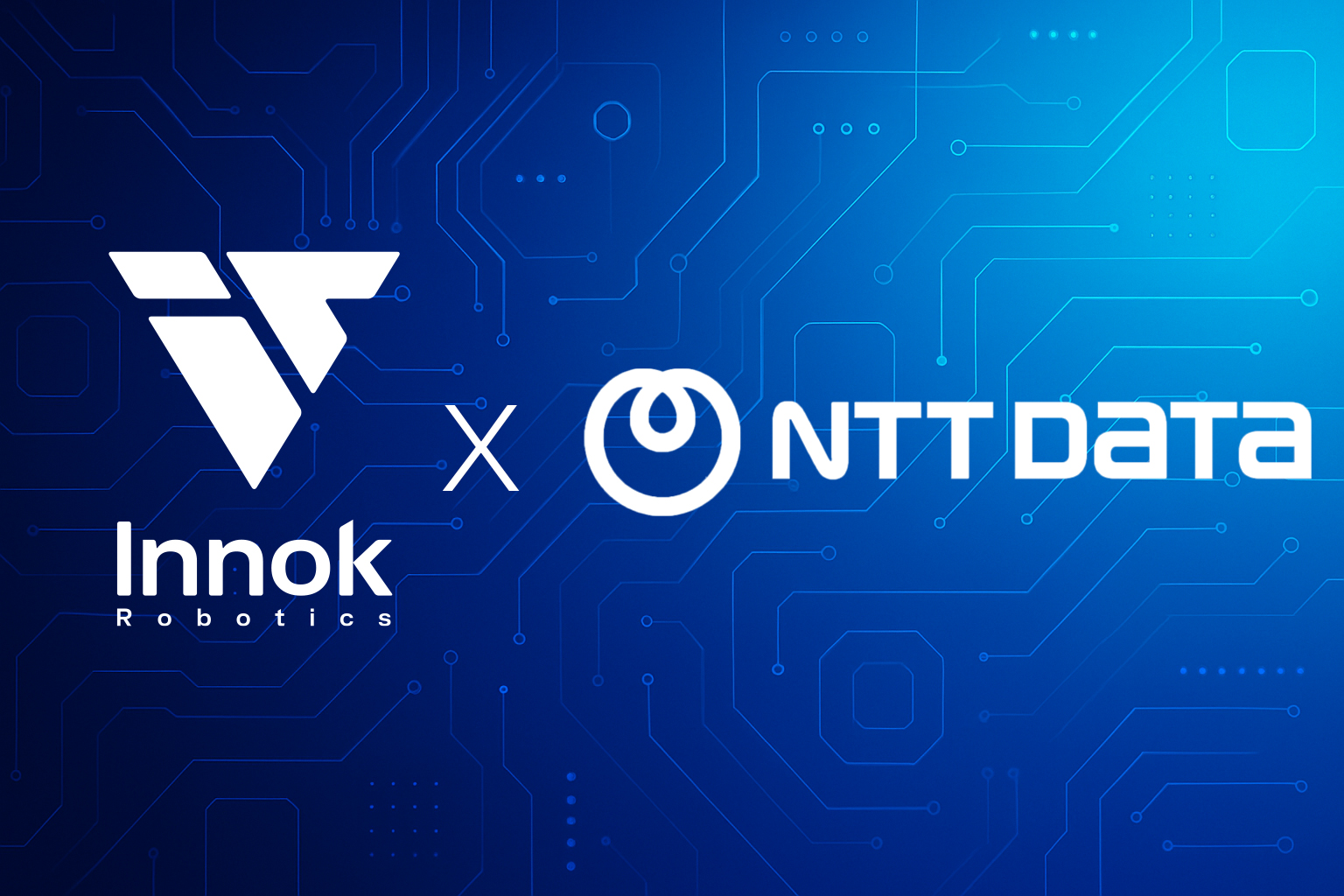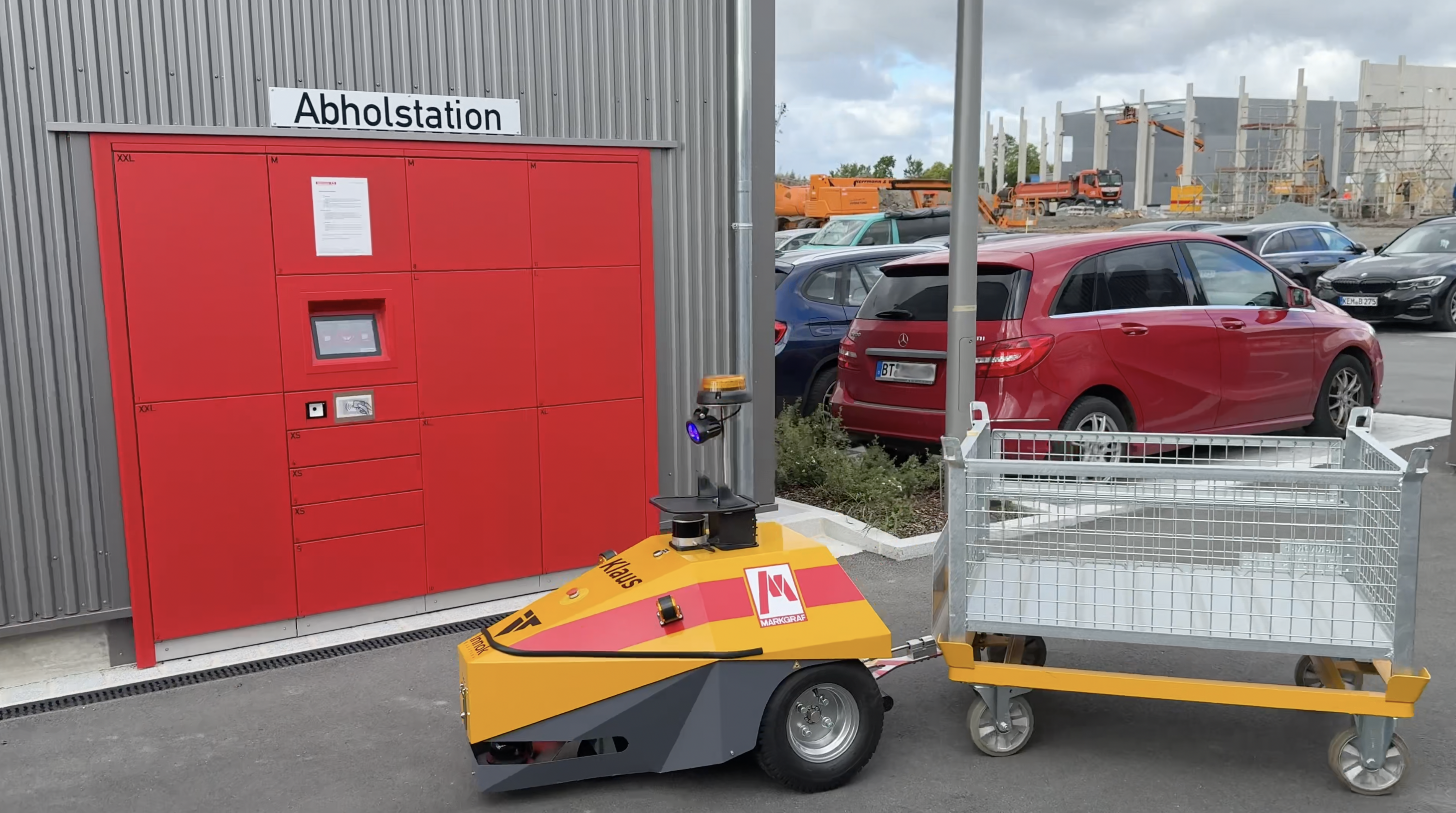Lunch & Learn: The new Innok webinar starts - premiere on December 11 at 12:00 noon
Innok Robotics launches its own webinar series: Lunch & Learn - The Innok Webinar.
7 min read
 Innok Robotics
10-16-2025
Innok Robotics
10-16-2025

Where large storage areas used to serve as a safety buffer, the industry now relies on lean processes and precise supply. The shift from traditional stockpiling to "Just in Time (JIT)" and "Just in Sequence (JIS)" has fundamentally changed the requirements for in-house logistics: Materials must not only arrive at their respective destinations on time, but in the correct sequence and synchronized with the production cycle. The precision required for this calls for new transportation solutions.
The autonomous or manual tugger train offers an economical and safe alternative to conventional vehicles. The modular unit consisting of a towing vehicle and specialized trailers enables the simultaneous, track-accurate transport of different types of cargo. This makes the tugger train the linchpin of lean and flexible cycle-based intralogistics. Discover the possibilities that arise from the use of tugger trains here.
Table of contents:
Tugger trains are internal means of transportation that consist of a classic tractor unit or an autonomous robot and several trailers. They are primarily used in production logistics to transport materials to their destination at precise intervals. In contrast to individual transports with forklift trucks and other industrial trucks, the tugger train follows fixed schedules and predefined routes. This makes it particularly suitable for synchronized production systems, such as just-in-time or just-in-sequence supply.
The targeted combination of different trailer types allows you to transport a wide range of materials efficiently and accurately in a single tugger train. This creates a flexible transport network that can be seamlessly integrated into synchronized processes and sustainably stabilizes the material flow.
The advantages of tugger trains can be summarized as follows:
The savings potential is enormous. A tugger train with several trailers replaces most of the forklift truck journeys previously required. This not only relieves the burden on plant traffic, but also saves energy and manpower. The personnel are available for more value-adding activities.
The purchase of a tugger train naturally involves investment costs. However, these are often quickly amortized, especially with regular use and clearly structured material flows. The total costs vary greatly as they depend on several factors, such as the number of trailers, the load carriers used, the infrastructure required and the control requirements. Manual systems with standardized components are usually cheaper than automated tugger trains with integrated sensors and digital control systems, but they also require a driver. A careful analysis of requirements helps to select the right system in terms of economy and functionality.

A tugger train can demonstrate its strengths wherever material has to be moved horizontally from A to B over longer distances with precise timing. Typically, tugger trains are used in the manufacturing industry to transport production materials from the warehouse to the production and assembly sites and to collect finished parts and empties at the same time. They are often integrated into digital control systems or operate on demand, and increasingly also autonomously.
In general, tugger trains are used within production halls, storage areas or between individual production stations, i.e. indoors. However, these systems have also proven their worth in outdoor applications, such as transportation between different buildings or across factory premises.
The tugger train is particularly widespread in the automotive industry, in mechanical engineering and in electrical and furniture production, i.e. where many different components have to be provided in a defined sequence and at the right time. It is also increasingly used in food processing and the pharmaceutical industry, where standardized transport routes and hygienically safe processes are required. The tugger train is equally suitable for in-house waste disposal and for transportation tasks at airports and railroad stations or in amusement parks.
Even though tugger trains can be used both indoors and outdoors, outdoor use brings with it some specific challenges. On the one hand, uneven road surfaces, inclines, different surfaces and changing light conditions require more robust vehicle technology and additional safety measures. On the other hand, weather influences such as rain, snow or changing temperatures can impair the functionality of trailers, load carriers and couplings.
Weatherproof components, precise route planning and close coordination with the structural environment are essential to ensure that the tugger train also functions reliably and safely outdoors. These additional requirements must be taken into account for an outdoor tugger train and are fulfilled in a special way by the INDUROS autonomous mobile transport robot, for example.

A tugger train essentially consists of two or three elements. There is always a towing vehicle with one or more trailers and then, if required, additional load carriers that hold the material to be transported.
The towing vehicle forms the heart of the system. Its task is to move the attached transport modules safely along the defined routes. Depending on the area of application (indoor and/or outdoor), different vehicle types are used, ranging from the classic tractor with driver's seat to autonomously navigating towing vehicles that move autonomously through the production halls or across the factory premises using sensors and digital control.
Modern towing vehicles often have electric drives that are emission-free and energy-efficient. Their compact design enables tight turning maneuvers, which means they require relatively little space. At the same time, integrated safety systems ensure reliable operation even in complex, intermittent production environments.
These mobile modules are coupled to the tractor unit. They form the basis for transportation and are equipped with different pick-up systems depending on the type. Common variants include pallet wagons, lattice boxes, platform trailers, frame trailers and so-called cab trailers with an integrated pick-up device for load carriers. Many models allow loading and unloading from both sides or are prepared for automated transfers. Thanks to their modularity, tugger trains can be flexibly adapted to changing requirements, for example for series production, special assembly or in-house disposal.
A distinction is made between floor-level and non-floor-level systems. Floor-level means that the optional load carrier can be inserted at floor level. A special loading platform is therefore not required. Non-floor-level means that the load carrier must be pushed or rolled onto the trailer via a ramp.
The optional elements that hold the transported goods are referred to as load carriers. They differ in terms of loading direction and loading type. With regard to the loading direction, a distinction is made between one-sided and two-sided loading. The type of loading results from the interaction with the trailers: depending on the system, the goods are picked up at ground level or via a ramp.
Typical goods carrier systems are
C and E frames and U-frames are suitable for floor-level storage; platform frames and Quick-Save frames are designed for non-floor-level storage. The type of trailer used determines which variant is used.

The exact way a tugger train works depends on the underlying supply concept. The most common is the milk run principle, a cycle-based circulation system that works as follows:
Precisely planned routing is essential for the performance of a tugger train system. The most common procedures in connection with material supply via tugger trains are the just-in-time and milk run concepts.
When transporting material according to the JIT principle, the quantity of material required for the production step is provided on time. To achieve this, the routing must be coordinated in such a way that it reliably serves the production cycle: with routes that are as conflict-free as possible, clearly defined stops and optimized zones for loading and unloading.
In milk run concepts, where several stations are supplied in a fixed loop, the coordination between process requirements and routing is particularly critical. The name of this approach is derived from the traditional milk delivery system in the USA, in which so-called milk boys served several households in a fixed sequence and placed a full milk bottle wherever they found an empty one. In logistics, this concept is usually used in conjunction with the two-bin principle.
A third variant is the dynamically controlled tugger train, which adapts flexibly to current requirements. The prerequisite for this is an intelligent route logic with which spontaneous rerouting or prioritization can be reliably implemented. Control and operation should also be as simple as possible for staff via a digital interface, e.g. to call the tugger train or send it back on its way to its destination. Many companies do not have such a digitalized order control system, but it is the basis for being able to react quickly to changes in the process.
Despite its flexibility, the tugger train reaches its limits in very dynamic production environments with a high number of variants and changing material requirements. The principle of fixed routes and cycles reaches its structural limits, particularly in the case of decentralized requirements, changes at short notice or just-in-sequence supplies.
Autonomous robots such as the INDUROS transport robot, which can navigate more freely in space, react to process changes in real time and deliver individual load carriers as required, are a smart alternative to the tugger train. Thanks to these capabilities, they are particularly suitable for just-in-time and just-in-sequence scenarios, where precise material provision is essential. Compared to a tugger train in the milk run concept, autonomous robots score points with the ability to avoid empty runs. There is also no need for separate logistics zones, as they automatically detect obstacles and brake proactively and dynamically adapt their route if required. This is a clear advantage in agile, human-centered production environments.
While tugger trains generally have advantages in standardized, cycle-based transport of goods, autonomous robots open up additional scope for agile, scalable and resource-saving intralogistics. The autonomous coupling and uncoupling of trolleys enables decoupling from other processes and ensures a completely autonomous process. In addition to working hours, ghost shifts can be used to remove empties and provide new material. In addition to personnel savings, an autonomous tugger train often brings many process-related advantages that can only be precisely quantified after implementation. Which system is ultimately best suited depends on the process design, the material structure and the desired degree of automation.
Would you like to know how our INDUROS autonomous mobile transport robot can best suit your processes and what savings potential you can achieve in your material transportation? Download our white paper or contact us directly. Together we will analyze your requirements and find the ideal solution for your application.
.png)
Innok Robotics launches its own webinar series: Lunch & Learn - The Innok Webinar.

Innok Robotics is now an innovation partner of NTT Data - one of the world's leading IT and consulting companies in the field of digital...

Our project at Markgraf shows how modern automation creates real added value.